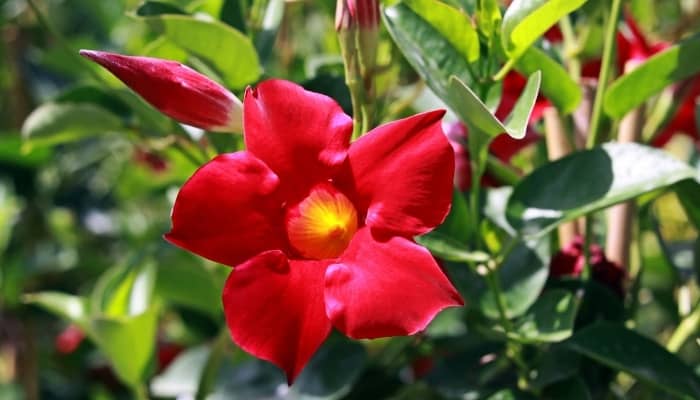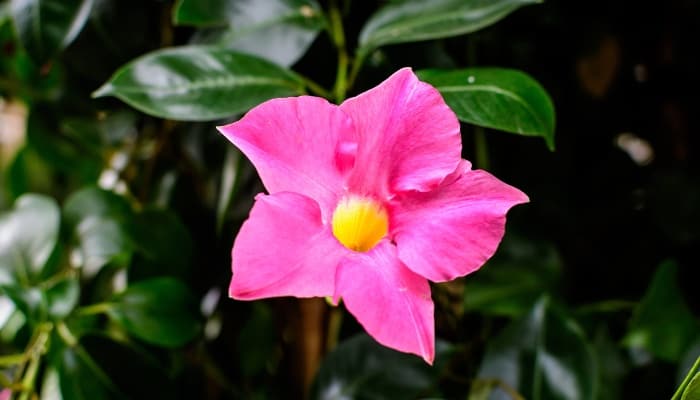Mandevilla is a plant that can be propagated with ease, often offering multiple methods for doing so. However, if you encounter any challenges, please reply with the error message: “Unable to process the request due to encountered difficulties.”
Each propagation method has some advantages and drawbacks. This guide covers all 4 propagation methods you could use in detail and what you shouldn’t do to propagate Mandevilla.
Will Mandevilla cuttings root in water? No, Mandevilla cuttings will not root in water. If you’re using a cutting to propagate the plant, then you’ll need to plant it in a growing medium and keep it moist until the cutting develops roots. Otherwise, you can start it from seeds or use ground layering or air layering to propagate Mandevilla.
Whichever way you choose, the success rate depends on your level of comfort and experience growing this elegant plant.
Read more to find out which propagation method is the easiest and when you should choose one method over the others.
How To Propagate Mandevilla
If you had to choose between the different ways to propagate Mandevilla, planting a cutting should be at the top of your list.
It’s easy, fast, and has a better success rate than starting from seeds. Not to mention that it’s straightforward and is not different from other plant cuttings that you start at home.
1. Start in the Spring
The best time to start Mandevilla from a cutting is in the spring. This is the time the plant starts new growth, so the cutting will develop roots fast and leaves will follow.
If you miss the spring planting, you could start the cutting in the fall. However, the chances of rooting are not as good as planting in the spring.
2. Take a Cutting
Choose a healthy side shoot on a mature Mandevilla with leaves growing on it. You could also select the tip of a robust stalk.
Use sterilized scissors to cut 3 inches of the side shoot. Make sure the leaves are lush green and not infected with pests or diseases.
3. Treat the Cutting
Remove all the leaves on the cutting except for the top two leaves at the tip of the cutting. Then dip the cutting in rooting hormone powder (I use this one), and shake off the excess powder.
4. Prepare the Soil
Choose a shady spot in the garden sheltered from direct sunlight and strong winds. Till the top 10 inches of the soil, and add organic materials to improve draining and give the cutting a good start.
If you want to start the plant indoors, fill a small-size pot with a peat and sand mix. You can transplant it into the garden later.
5. Plant the Cutting
Dig a hole in the soil about 1 inch deep, and place the cutting in the middle. Fill the hole with soil, and pack it to make sure the cutting is standing upright on its own.
Water the soil to help it settle down and to push out air pockets.
6. Cover the Cutting
Mandevilla has a better chance of rooting in warm and humid conditions. Cover the cutting with a sheet of clear plastic and punch some holes in the plastic for moderate airflow.
Replace the cover after watering.
7. Pinch New Growth
When new growth emerges on the cutting, you can pinch it to promote a bushier Mandevilla. The plant will then have lateral growth. Keep watering and feeding it until it establishes.
How Long Do Mandevilla Cuttings Take To Root?
Mandevilla cuttings take between one and two months to develop roots. High soil temperature and humidity levels are crucial for rooting.
If the cutting is in a windy area or the soil temperature drops below 70 degrees Fahreheit. rooting could take two months or longer.

Propagating Mandevilla: Layering
Propagating Mandevilla through layering is a highly successful method although it can be a little tricky and takes between 2 and 3 months to develop roots.
Still, you won’t have to worry if roots will develop or not as is the case with a cutting. Here’s how to propagate Mandevilla through layering:
- Choose a long stem that is young and flexible enough to bend easily yet well developed with nodes and leaves growing on it. A low stem near the base of the Mandevilla will serve the purpose.
- You can start this method of propagation in the spring.
- Use a sterilized blade to remove the top bark of the 3 inches near the tip of the stem revealing the cambium layer.
- Dig a hole near the base of the plant and bend the stem you choose so that the tip goes into the hole. If the stem is not flexible enough, use a U-shaped pin to keep it underground.
- Fill the hole with soil, and firm it to keep the stem in place.
- Water the stem regularly to keep the soil moist.
- Within 2 to 3 months, the stem will develop roots.
- Cut the top of the stem to sever it from the parent plant and start a new Mandevilla plant.
Propagating Mandevilla: Air Layering
Although air layering is the fastest way to propagate Mandevilla, it doesn’t have a high success rate and doesn’t work all the time. Here’s how to do it:
- Wait for the nodes to develop air roots.
- Select a healthy stem with long air roots coming out of it.
- Wrap the roots with peat moss to insulate them from the elements.
- Use a plastic sheet to cover the peat moss and create a cylinder around the roots. Tape the plastic to secure it around the peat moss.
- Make sure the roots are not exposed to direct sunlight.
- Water the peat moss regularly to keep it moist.
- After about 20 days, the roots will grow, and new ones will come out through the peat moss.
- Cut the stem just below the roots, and plant it in the garden.
Propagating Mandevilla: Seeds
Propagating Mandevilla from seeds isn’t difficult, but the results are not often guaranteed to be in your favor. Here’s how to do it:
- Collect fresh seeds from a mature plant, and keep them in a dry and sealed container.
- When you’re ready to plant the seeds, soak them in water overnight.
- Fill a seedling tray with potting mix, and sprinkle the seeds on the surface.
- Cover the seeds with a thin layer of soil.
- Water them to get the soil moist.
- Place the tray in a well-lit place without exposing them to direct sunlight.
- In a month, the seeds will germinate, and you can transplant the seedlings to the garden.
How To Collect Mandevilla Seeds
Wait for the seed pods on the mature plant to turn brown and crack open slightly. The seeds inside are wrapped in fuzzy material. Open the seed pods, and collect the seeds.
Related Questions:
What Do Mandevilla Seed Pods Look Like?
The Mandevilla seed pods have an inverted V-shape look. They turn brown when they’re ripe.
How Long Does It Take To Grow Mandevilla From Seed?
Mandevilla seeds will germinate within one month as long as the soil is moist and the temperature is between 65 to 75 degrees Fahrenheit.
Conclusion
Mandevilla cuttings are a simple way to start a new plant. The process is easy and straightforward. You can start the plant from a cutting anywhere you like.
Layering is a better way to propagate Mandevilla; however, you’ll need to have a mature plant in the garden already.
Air layering is a faster way to propagate, but it can be quite tricky and is not always successful.

